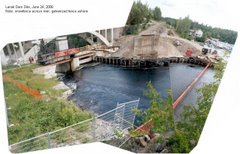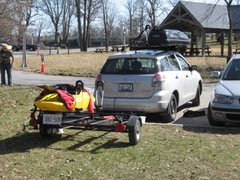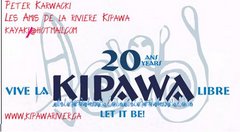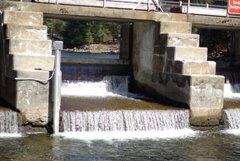PRINCIPLES OF THE PRESERVATION AND USE OF SMALL
AND MEDIUM RIVERS
V. S. Lapshenkov UDC 551.482.2
In contrast to the hydrological interpretation of terms, "river" should be defined as a natural set of interrelated entities,
the unity of whose formation and development is dictated by river flow. It is an entity of a living and nonliving (inert) nature,
and rivers are therefore bioinert systems of the Earth.
Agricultural, ecological, and recreational usefulness of rivers is determined by their status: from maximum full productivity
with annual renewal of useable resources to complete unsuitableness and even handfulness. The status of rivers is determined
by a regime that depends on both natural factors, and also anthropogenic load.
The following are referred to as basic components of the river complex, which provide value (usefulness right up to
irreplacability of river systems):
river water (drinking and industrial needs, habitat for ichthyofauna, aquatic birds, and, irrigation and water supply,
dilution of waste water, the necessary conditions for water transport, and an effective body when used in hydraulic power
engineering);
river channel (discharge of excess water and waste water, regional drains, condition for year-round life support of river
biosynoses, recreation);
flood plains (regulation of flood conditions with a reduction in maximum flow rates and an increase in the duration of
the flood, active improvement of water quality, high productivity of flooded lands, recreation);
permeable soils that fill the erosion in-cutting of the river valley (a required component for drainage and the wetting of
bottomland soils);
biosynoses (river productivity, effect on channel processes, recreation);
quarries producing nonmetallic materials; and,
recreation zones (optimal combination of landscape elements, water surface, and vegetative cover).
The basic problem of river-system protection is the preservation of the above-enumerated useful entities. Retention of
the properties of the river and the ability to reproduce its own natural resources and improve its condition on an annual basis
serves as a criterion of preservation quality.
Increases in the productivity of river systems to the optimal can be achieved by taking recultivation and agricultural
measures within limits ensuring guaranteed annual restoration of natural resources (the volume and regime of the water flow,
fertility of flood-plain areas, water supply, optimal conditions for river processes, etc.).
As studies have indicated, river systems without active continuous preservation and technically literate use of their
natural resources cannot exist under rather high levels of development in the national economy: degradation of individual rivers
and their segments occurs right up to their death. The matter of the preservation and rational use of rivers should be entrusted
to a special technical service that can be created for each river system with a medium river at the head. Conversion from
spontaneous use of river resources to their literate engineering exploitation is required.
Measures that stimulate natural creative forces and useful processes are based on the principle of the preservation and
use of rivers. Their active origin is in the water flow.
To implement this principle, it is necessary to create the possibility of control over the river system by taking required
organizational, agrotechnical, forest-reclamation, hydrotechnical, sanitary-technical, and operational measures.
The means of controlling a natural-technical riparian water-distribution system should affect the following elements,
which ensure the preservation and productivity of the rivers:
Translated from Gidrotekhnicheskoe Stroitel'stvo, No. 12, pp. 8-9, December, 1992.
0018-822CJ/92/2612-0767512.50 9 Plenum Publishing Corporation 767
Principles of the preservation and use of small and medium rivers
Journal Power Technology and Engineering (formerly Hydrotechnical Construction)
Publisher Springer New York
ISSN 1570-145X (Print) 1570-1468 (Online)
Issue Volume 26, Number 12 / December, 1992
DOI 10.1007/BF01545814
Pages 767-768
Subject Collection Engineering
SpringerLink Date Monday, May 02, 2005
Friday, September 18, 2009
Thursday, September 3, 2009
Monday, August 17, 2009
What's Next in River Preservation
The landscape is fairly bleak for the river preservationist these days.
Most of the local water protection has fallen under the umbrella of government authorities - in Ontario ( a side effect of Walkerton)
The Navigable Waters Protection Act has been gutted.
The Environmental Protection Act has no teeth.
The government has no patience for NGO's acting in the public interest: The Justice Department is still asking Les Amis for Court Costs? - initially waived by the lower court justice Noel.
There is no National Water Policy in Canada.
The Tar Sands project continues to build up sludge in its tar ponds, all set to be dumped by into the Athabasca river.
The Salmon have not started their migration up the Fraser River
The Ice Sheets are melting.
Cheery stuff, this.
And so it appears that this author has nothing to say that can possibly make a difference. The shot gun approach is valueless and I have no target for my sniper rifle. I think I'm done on this front unless somebody out there can offer up a suggestion?
Most of the local water protection has fallen under the umbrella of government authorities - in Ontario ( a side effect of Walkerton)
The Navigable Waters Protection Act has been gutted.
The Environmental Protection Act has no teeth.
The government has no patience for NGO's acting in the public interest: The Justice Department is still asking Les Amis for Court Costs? - initially waived by the lower court justice Noel.
There is no National Water Policy in Canada.
The Tar Sands project continues to build up sludge in its tar ponds, all set to be dumped by into the Athabasca river.
The Salmon have not started their migration up the Fraser River
The Ice Sheets are melting.
Cheery stuff, this.
And so it appears that this author has nothing to say that can possibly make a difference. The shot gun approach is valueless and I have no target for my sniper rifle. I think I'm done on this front unless somebody out there can offer up a suggestion?
Thursday, August 13, 2009
Hydro Quebec, Kipawa River, Les Amis and Things in General
The plan has been to divert the Kipawa through an entirely new channel/outflow to capture the entire potential between the height of Lake Kipawa and Lake Temiskaming.
I'm not sure about the 132 MW figure. Some have said that it would require the diversion of water from the Dumoine river as well.
As for the EA, it is proponent driven, and I don't know of any cases recently where the EA has stopped development of projects like this.
I do remember seeing a paper abstract that was to be presented at the International Impact Assessment Association by two Hydro Quebec engineers of which Rougon was one. They said that calculating the "reserve flow" was the main issue associated with the Tabaret project. Reserve Flow concerns the minimum amount of water they could leave in the Kipawa and I think that was around 11 cfs and in any case the Laniel Dam was designed specifically to release that amount of water.
The process will involve an EA but my prediction is that the EA will suggest no significant environmental effect... I predict that the province will assign water rights to Quebec Hydro, that they will grant all the necessary permits. I also predict that, most people will never hear about this or have very little input into it, but we may see some protests from the Algonquins. The media may cover it cursorily. Naturally the MRC in Temiskaming will be fully supportive as they have been waiting for their $400,000 a year payments as promised since 1998.
Laniel have their new renovated dam, I assume they will be happy about this project as well as they will see any residual/spin off construction dollars as "good" for Laniel.
It may be useful to have Les Amis submit letters to Hydro Quebec, the Quebec Minsitry of Natural Resources to be put on the mailing list for any announcements or notices concerning public meetings and mailings - they'll do that but everything will be in French.
I think we need other ideas about how to proceed strategically on this file. Fondation Rivieres (FR), the Montreal based river preservation group has been notably mute about the Kipawa. when they did their magazine spread on River Preservation with Roy Dupuis they didn't mention the Kipawa at all. But they may be able to assist us now that Tabaret is back on the Strategic Plan.
I know that the Montreal Paddling Club is our major supporter on this file. We should try to support their efforts as much as possible, to alert the Quebec Media to at least ensure that the process is kept open to public input even if we think the end result is assured.
People will ask years from now, "what did you do while all this was happening?" Our consciences should be clear.
“Les Ami(e)s de la rivière Kipawa” (sic!) is a published link on the FR site. It rather appears that the organization went dormant in May 2008 based on the lack of activity.
The Montreal Club does have many other good whitewater destinations within easy reach of Montreal but the Club gave Les Ami’s 3k for the first crack at the legal challenge of the environmental assessment for the Laniel dam refurbishment.
The Hydro Quebec plan is that the annual energy to be generated at Tabaret is 0.7 TWh. Compare that to the proposed 132 MW generating capacity. The generating capacity can be as much as HQ chooses to install but the annual energy out is strictly a function of the potential (head) and the volume of water passed through the station. The apparent average utilization of the proposed 132MW station is 22%
The potential Dumoine watershed diversion is not far fetched. HQ provided for diverting part of the Moise watershed into their Sainte-Marguerite project. And they seem to be about to do just that.
I'm not sure about the 132 MW figure. Some have said that it would require the diversion of water from the Dumoine river as well.
As for the EA, it is proponent driven, and I don't know of any cases recently where the EA has stopped development of projects like this.
I do remember seeing a paper abstract that was to be presented at the International Impact Assessment Association by two Hydro Quebec engineers of which Rougon was one. They said that calculating the "reserve flow" was the main issue associated with the Tabaret project. Reserve Flow concerns the minimum amount of water they could leave in the Kipawa and I think that was around 11 cfs and in any case the Laniel Dam was designed specifically to release that amount of water.
The process will involve an EA but my prediction is that the EA will suggest no significant environmental effect... I predict that the province will assign water rights to Quebec Hydro, that they will grant all the necessary permits. I also predict that, most people will never hear about this or have very little input into it, but we may see some protests from the Algonquins. The media may cover it cursorily. Naturally the MRC in Temiskaming will be fully supportive as they have been waiting for their $400,000 a year payments as promised since 1998.
Laniel have their new renovated dam, I assume they will be happy about this project as well as they will see any residual/spin off construction dollars as "good" for Laniel.
It may be useful to have Les Amis submit letters to Hydro Quebec, the Quebec Minsitry of Natural Resources to be put on the mailing list for any announcements or notices concerning public meetings and mailings - they'll do that but everything will be in French.
I think we need other ideas about how to proceed strategically on this file. Fondation Rivieres (FR), the Montreal based river preservation group has been notably mute about the Kipawa. when they did their magazine spread on River Preservation with Roy Dupuis they didn't mention the Kipawa at all. But they may be able to assist us now that Tabaret is back on the Strategic Plan.
I know that the Montreal Paddling Club is our major supporter on this file. We should try to support their efforts as much as possible, to alert the Quebec Media to at least ensure that the process is kept open to public input even if we think the end result is assured.
People will ask years from now, "what did you do while all this was happening?" Our consciences should be clear.
“Les Ami(e)s de la rivière Kipawa” (sic!) is a published link on the FR site. It rather appears that the organization went dormant in May 2008 based on the lack of activity.
The Montreal Club does have many other good whitewater destinations within easy reach of Montreal but the Club gave Les Ami’s 3k for the first crack at the legal challenge of the environmental assessment for the Laniel dam refurbishment.
The Hydro Quebec plan is that the annual energy to be generated at Tabaret is 0.7 TWh. Compare that to the proposed 132 MW generating capacity. The generating capacity can be as much as HQ chooses to install but the annual energy out is strictly a function of the potential (head) and the volume of water passed through the station. The apparent average utilization of the proposed 132MW station is 22%
The potential Dumoine watershed diversion is not far fetched. HQ provided for diverting part of the Moise watershed into their Sainte-Marguerite project. And they seem to be about to do just that.
Friday, July 31, 2009
EA needs to be done?

What I find offensive is the "cats in the bag" attitude about the project. It 'will' be put into service by 2015, the EA would be a sham.
http://www.hydroquebec.com/publications/fr/plan_strategique/pdf/plan-strategique-2009-2013.pdf
"groupe. Ils comprennent
notamment un projet de centrale – la centrale Tabaret – à proximité du barrage de Kipawa au
Témiscamingue et un autre projet sur la rivière Magpie, pour lesquels l’évaluation environnementale
détaillée reste à réaliser." page 23
TABARET REARS UGLY HEAD -
Some news on Hydro Quebec's dams for Magpie and Kipawa
Hydro Quebec released its 2009-2013 strategic plan today. It will invest $25 Billion in Quebec over the next five years. A large part of that will be on major hydro projects:
"Hydro-Québec will continue to develop major hydroelectric projects such
as Romaine and Petit-Mécatina, in addition to bringing 4,000 MW of wind power
onto the grid," said Thierry Vandal, Hydro-Québec's President and Chief
Executive Officer....
Hydro-Québec Production plans to develop a portfolio of 3,500 MW as
part of the Québec government's Northern Plan, including 3,000 MW in major
hydropower projects; these projects will be presented in a future Strategic
Plan.
from - http://www.newswire.ca/en/releases/archive/July2009/30/c9809.html
According to a story in Le Soleil, the other projects that are on the drawing board are dams for the Magpie (850 MW), a third dam on the Sainte-Marguerite (440 MW), and more dams on the Manicouagan (330 MW) all in the Cote-Nord region of Quebec (the North Shore of the Saint-Lawrence). The only project mentioned outside of that region is the Tabaret project on the Kipawa (132 MW).
The link for that article is:
http://www.cyberpresse.ca/le-soleil/affaires/actualite-economique/200907/29/01-888356-projets-hydroelectriques-hydro-quebec-donne-un-coup-daccelerateur.php
I'm not sure what his sources are but the Hydro Quebec plans for the other Cote-Nord projects including the Magpie were first leaked/mentioned in June:
http://www.lesaffaires.com/article/0/energie/2009-06-11/494652/hydroqueteacutebec-lorgne-la-rivietegravere-magpie.fr.html
The is the first we've heard about the Kipawa project in the media in a while.
Hydro Quebec released its 2009-2013 strategic plan today. It will invest $25 Billion in Quebec over the next five years. A large part of that will be on major hydro projects:
"Hydro-Québec will continue to develop major hydroelectric projects such
as Romaine and Petit-Mécatina, in addition to bringing 4,000 MW of wind power
onto the grid," said Thierry Vandal, Hydro-Québec's President and Chief
Executive Officer....
Hydro-Québec Production plans to develop a portfolio of 3,500 MW as
part of the Québec government's Northern Plan, including 3,000 MW in major
hydropower projects; these projects will be presented in a future Strategic
Plan.
from - http://www.newswire.ca/en/releases/archive/July2009/30/c9809.html
According to a story in Le Soleil, the other projects that are on the drawing board are dams for the Magpie (850 MW), a third dam on the Sainte-Marguerite (440 MW), and more dams on the Manicouagan (330 MW) all in the Cote-Nord region of Quebec (the North Shore of the Saint-Lawrence). The only project mentioned outside of that region is the Tabaret project on the Kipawa (132 MW).
The link for that article is:
http://www.cyberpresse.ca/le-soleil/affaires/actualite-economique/200907/29/01-888356-projets-hydroelectriques-hydro-quebec-donne-un-coup-daccelerateur.php
I'm not sure what his sources are but the Hydro Quebec plans for the other Cote-Nord projects including the Magpie were first leaked/mentioned in June:
http://www.lesaffaires.com/article/0/energie/2009-06-11/494652/hydroqueteacutebec-lorgne-la-rivietegravere-magpie.fr.html
The is the first we've heard about the Kipawa project in the media in a while.
Subscribe to:
Posts (Atom)
Useful Links
- Mount Gox - Bitcoin exchange
- Reggie Middleton's Rapier Analysis
- Ontario Rivers Alliance
- Geodesic Dome Construction
- Canadian Disaster Preparedness
- Globe and Mail
- Chris' The Weekly Telegram
- Michael Rupert of CollapseNet
- Max Keiser
- Nicole Foss Blog - the automatic earth
- Peak Moment Discussions
- Scotia Mocatta Bullion Store
- Dimitry Orlov - Peak Moment Discussions
- Jims's ISFCR Blog
- Jenny Right Side Blog
- Scott Sorensen
Alternative Energy Sites I like
The Queen is not amused!

http://www.ispeakforcanadianrivers.ca/
The Ashlu river: it could happen to you

Whitewater Ontario

Working Hard to Protect Canada's Paddling Resources
Whitewater Ontario - Mission Statement
It is Whitewater Ontario’s mission to support the whitewater paddling community through the promotion, development and growth of the sport in its various disciplines.
We accomplish this through the development of events, resources, clubs, and programs for personal and athletic development, regardless of skill level or focus, to ensure a high standard of safety and competency;
We advocate safe and environmentally responsible access and use of Ontario’s rivers.
Whitewater Ontario is the sport governing body in the province, and represents provincial interests within the national body Whitewater Canada and the Canadian Canoe Association
http://www.whitewaterontario.ca/page/mission.asp
Kipawa, Tabaret, and Opemican
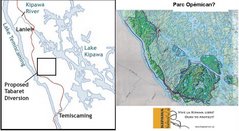
If Hydro Quebec is not actively pursuing Tabaret what is that bite out of Opemican for?
Kipawa Dam: After

Laniel Dam at 2006 Rally
Where is the Kipawa
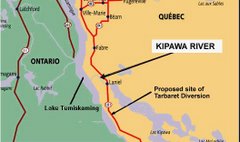
Kipawa flows into lake Temiskamingue, running from Kipawa Lake, under hwy 101 in Quebec
Kipawa Dam

laniel dam at 2004 River Rally
Tabaret is a Bad Idea
About the Kipawa
The best thing paddlers can do to help the cause of the Kipawa:
1. attend the rally and bring others including non paddlers to attend and buy beer and have fun
2. write your MP /MNA and raise the issue and post your objections -1 letter = 200 who didn't write
3. Write Thierry Vandal the CEO of Hydro Quebec strongly opposing the 132 MW standard decrying the use of "diversion" as the most environmentally inappropriate method of power production
4. Write Jean Charest, Premier of Quebec protesting that either the algonquin or the tabaret project will eliminate all other values on the Kipawa River by turning it into a dry gulch.
5. See if you can get other allied groups interested by showing your own interest, ie the Sierra Defense Fund, Earthwild, MEC, and so on.
6. Demand further consultation
7. Currently we are at the point where we need to sway public opinion and raise awareness.
However, if all else fails, don't get mad, simply disrupt, foment, and protest . The Monkey Wrench Gang.
Have you read Edward Abbey?
Important Addresses
CEO,Hydro Québec, 75 boul René Levesque, Montreal, P.Q., H2Z 1A4Caille.andre@hydro.qc.ca
The best thing paddlers can do to help the cause of the Kipawa:
1. attend the rally and bring others including non paddlers to attend and buy beer and have fun
2. write your MP /MNA and raise the issue and post your objections -1 letter = 200 who didn't write
3. Write Thierry Vandal the CEO of Hydro Quebec strongly opposing the 132 MW standard decrying the use of "diversion" as the most environmentally inappropriate method of power production
4. Write Jean Charest, Premier of Quebec protesting that either the algonquin or the tabaret project will eliminate all other values on the Kipawa River by turning it into a dry gulch.
5. See if you can get other allied groups interested by showing your own interest, ie the Sierra Defense Fund, Earthwild, MEC, and so on.
6. Demand further consultation
7. Currently we are at the point where we need to sway public opinion and raise awareness.
However, if all else fails, don't get mad, simply disrupt, foment, and protest . The Monkey Wrench Gang.
Have you read Edward Abbey?
Important Addresses
CEO,Hydro Québec, 75 boul René Levesque, Montreal, P.Q., H2Z 1A4Caille.andre@hydro.qc.ca
Tabaret is a Bad Idea (Part Two)
Les Amis de la Riviere Kipawa is poised to use an application to the Federal Court to issue a Writ of Mandamus to ensure the Minster does what he is supposed to do, protect the public's right to navigate the water control structure at Laniel, Quebec using the Navigable Waters Protection Act. (see http://www.kipawariver.ca/)
In the now gutted Navigable Waters Protection Act lay the means by which the Minister of Transport could keep the public right of passage down our great Canadian Heritage, our rivers and streams which are threatened especially by resource corporations and power brokers such as Hydro Quebec.
These powerful entities continue to petition that 'this' river or 'that' stream is not navigable and therefore not protectable.
I don't say that dams and bridges should not be built, only that if they are, historical navigation rights should be considered and preserved by making reasonable accommodations for recreational boaters.
It is the Minister of Transport, in exercising the right to allow or disallow work on or over a navigable waterway is what keeps boats and recreational boaters plying our waterways.
To many recent cases launched in the Federal Court concerning the Navigable Waters Protection Act, most recently the case of the Humber Environment Group of Cornerbrook Newfoundland versus the Cornerbrook Pulp and Paper Company indicates that the important oversight is not being faithfully performed. Have we really come to the point now where we must say "such and such a stream is one foot deep, possessing so many cubic feet per second flow and so on?" The answer to this is... YES!
The honourable Mr. Justice John A. O'Keefe, ruled that it had not been shown that the river was navigable. How convenient was that to the Minister? But either the Minister of Transport acts to protect our rivers and streams as a public right or he does not and that means rivers and streams currently enjoyed by kayakers and canoists.
Enough of the cheating, and double-talk. Canadians! our rivers and streams are our own, lets urge the Minister of Transport and the our government to protect them.
Peter Karwacki
In the now gutted Navigable Waters Protection Act lay the means by which the Minister of Transport could keep the public right of passage down our great Canadian Heritage, our rivers and streams which are threatened especially by resource corporations and power brokers such as Hydro Quebec.
These powerful entities continue to petition that 'this' river or 'that' stream is not navigable and therefore not protectable.
I don't say that dams and bridges should not be built, only that if they are, historical navigation rights should be considered and preserved by making reasonable accommodations for recreational boaters.
It is the Minister of Transport, in exercising the right to allow or disallow work on or over a navigable waterway is what keeps boats and recreational boaters plying our waterways.
To many recent cases launched in the Federal Court concerning the Navigable Waters Protection Act, most recently the case of the Humber Environment Group of Cornerbrook Newfoundland versus the Cornerbrook Pulp and Paper Company indicates that the important oversight is not being faithfully performed. Have we really come to the point now where we must say "such and such a stream is one foot deep, possessing so many cubic feet per second flow and so on?" The answer to this is... YES!
The honourable Mr. Justice John A. O'Keefe, ruled that it had not been shown that the river was navigable. How convenient was that to the Minister? But either the Minister of Transport acts to protect our rivers and streams as a public right or he does not and that means rivers and streams currently enjoyed by kayakers and canoists.
Enough of the cheating, and double-talk. Canadians! our rivers and streams are our own, lets urge the Minister of Transport and the our government to protect them.
Peter Karwacki
Tabaret is a Bad Idea (Part Three)
10 Reasons WhyTabaret is a Bad Idea1) Tabaret is too big. The station is designed to useevery drop of water available in the Kipawawatershed, but will run at only 44 percent capacity.We believe the Tabaret station is designed to usewater diverted from the Dumoine River into theKipawa watershed in the future.
2) The Tabaret project will eliminate the aquaticecosystem of the Kipawa River.The Tabaret project plan involves the diversion of a16-km section of the Kipawa River from its naturalstreambed into a new man-made outflow from LakeKipawa.
3) Tabaret will leave a large industrial footprint on thelandscape that will impact existing tourismoperations and eliminate future tourism potential.
4) The Tabaret project is an aggressive single-purposedevelopment, designed to maximize powergeneration at the expense of all other uses.
5) River-diversion, such as the Tabaret project, takinglarge amounts of water out of a river’s naturalstreambed and moving it to another place, is verydestructive to the natural environment.
6) The Kipawa River has been designated a protectedgreenspace in the region with severe limitations ondevelopment. This designation recognizes theecological, historical and natural heritage value ofthe river and the importance of protecting it.Tabaret will eliminate that value.
7) If necessary, there are other, smarter and morereasonable options for producing hydro power onthe Kipawa watershed. It is possible to build a lowimpactgenerating station on the Kipawa river, andmanage it as a “run-of-the-river” station, makinguse of natural flows while maintaining other values,with minimal impact on the environment.
8) The Kipawa watershed is a rich natural resource forthe Temiscaming Region, resonably close to largeurban areas, with huge untapped potential fortourism and recreation development in the future.Tabaret will severely reduce this potential.
9) Tabaret provides zero long-term economic benefitfor the region through employment. The plan is forthe station to be completely automated andremotely operated.
10) The Kipawa River is 12,000 years old. The riverwas here thousands of years before any peoplecame to the region. The Tabaret project will change all that.
Problems on a local River?
- There is more to do as well but you have to do your research and above all, don't give up.
- IN the meantime prepared a document itemizing the history of navigation of this spot and its recreational value. Use the Kipawa river history of navigation as a guide: see www.kipawariver.ca
- Under the Ministry of Environment guidelines you have a set period of time to petition the change under the environmental bill of rights, you may have limited time to take this action. But it involves going to court for a judicial review of the decision.
- 4. contact the ministry of natural resources officials and do the same thing.
- 3. contact the ministry of the environment and determine if they approved the project
- 2. determine if the dam was a legal dam, approved under the navigable waters protection act.
- 1. research the decision and timing of it to determine if an environmental assessment was done.
Minden Ontario
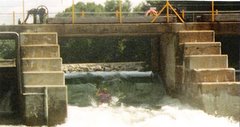
Gull River Water control at Horseshoe lake
A History of Navigation on the Kipawa River
Prior to the environmental assessment there was no signage at the Laniel Dam
T-Shirts Area: These are available now!

Send $25 and a stamped self addressed envelop for the Tshirt, and for the bumper sticker, a stamped and self addressed envelope with $5.00 for the bumper sticker to Les Amis de la rivière Kipawa, 80 Ontario St., Ottawa, Ontario, K1K 1K9 or click the link To purchase a Les Amis "T" contact Doug with the following information: Number of shirts:Sizes: Ship to Address: Method of Payment: cash, cheque and paypal, Shipto address:
Bumper Stickers Now Available

Get your bumper sticker and show your support for the Kipawa Legal Fund ! - send $5.00 in a Stamped, self addressed envelope to: Peter Karwacki Box 39111, Ottawa, Ontario, Canada, K1H 7X0


